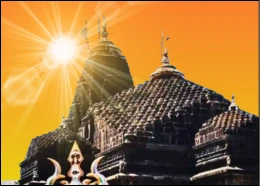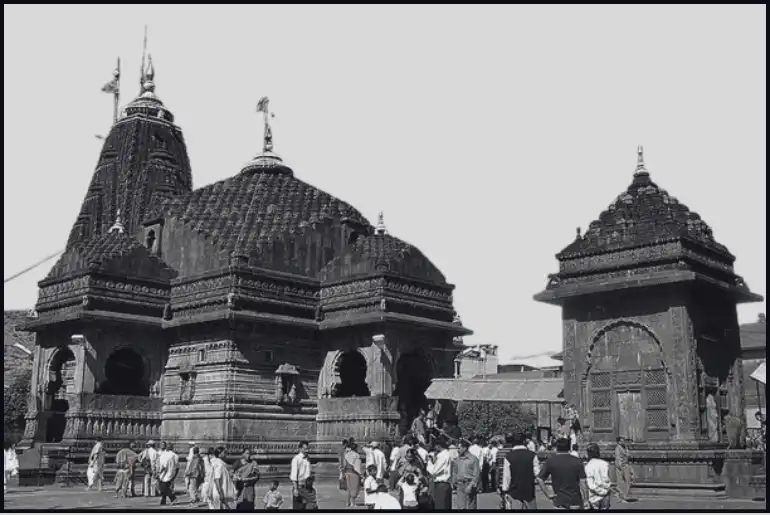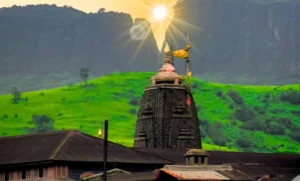Welcome To Trimbakeshwar Shiva Temple In Nashik
Book Online Puja With Authorized Pandit

Trimbakeshwar Shiva Temple is a renowned Hindu temple dedicated to Lord Shiva, situated in the town of Trimbak in the Nashik district of Maharashtra, India. Just 28 km from the bustling city of Nashik, It holds significant religious importance and is considered one of the twelve Jyotirlingas, which are believed to be manifestations of Lord Shiva. The temple is located at the source of the Godavari River, known as the Kushavarta Kund. This kund was built by Shrimant Sardar Raosaheb Parnekar, famously known as the Fadnavis of the Indore State. The current structure of the Trimbakeshwar Temple, a masterpiece of architecture and devotion, was constructed by Shri Nanasaheb, also known as Peshwa Balaji Baji Rao.
The architecture of the Trimbakeshwar Temple reflects a blend of traditional Hindu temple design with distinctively local elements. It features intricate carvings and sculptures depicting various mythological stories and deities. The temple complex also includes other shrines dedicated to various gods and goddesses. One unique feature of Trimbakeshwar Temple is its presence of three lingams, symbolic representations of Lord Shiva, enshrined within the sanctum sanctorum. These represent the Hindu trinity of Brahma, Vishnu, and Shiva, embodying creation, preservation, and destruction, respectively. The temple attracts a large number of devotees and tourists throughout the year, particularly during the Maha Shivaratri festival, when thousands of pilgrims gather here to offer prayers to Lord Shiva. Apart from its religious significance, Trimbakeshwar Temple also holds historical and cultural importance, contributing to the rich tapestry of Indian heritage.
History Of Trimbakeshwar Shiva Temple
Trimbakeshwar Shiva Temple, located at the foot of Brahmagiri mountain in Maharashtra’s Nashik district, is a deeply revered Hindu temple dedicated to Lord Shiva. Built between 1755 and 1786 AD by Shri Nanasaheb Peshwa, the temple is one of the twelve Jyotirlingas and holds immense spiritual significance. The temple is made of black stone and is surrounded by a tall stone wall, giving it a majestic presence. Within the temple complex is the sacred Kushavarta Tirtha, a pond believed to be the re-emergence point of the holy Ganga River. The temple is not only an architectural marvel but also a place rich in mythology, where legends like Lord Rama performing rituals for his father and Sage Gautama’s penance add to its sacredness. Devotees flock to the temple to seek blessings, pray at the unique Shiva Linga representing the Hindu trinity, and experience the deep spiritual atmosphere that has been cherished for centuries.

Many significant events are said to have taken place at the sacred Trimbakeshwar Shiva Temple. One such legend tells of Lord Rama visiting Trimbakeshwar to perform the Shraddha (a ritual for deceased ancestors) for his father, King Dashrath. Another story speaks of Sage Gautama taking a holy dip in the Kushavarta Pond, which lies within the temple premises. Upon entering the temple through the Mukhya Dwar (main gate), devotees are guided through multiple queues designed for their convenience. The journey begins with a striking white marble statue of Nandi, the sacred bull and vehicle (Vahana) of Lord Shiva, facing the Shiva Linga. It is believed that if one whispers their wishes into Nandi’s ear, he will convey them to Lord Shiva. Beyond the Nandi statue lies the Sabha Mandap, a spacious hall where devotees can meditate and pray, leading finally to the Gabhara, the sanctum where the Shiva Linga is enshrined.
Temple Timings And Entry For Darshan
Temple Timings
The temple is open to devotees every day of the week from 5:30 AM to 9:00 PM.
Special timings are observed during festivals and events, with extended hours as per the specific occasion.
During auspicious occasions, the timings may vary, so it’s advisable to check with the temple authorities for precise information.
Entry Requirements
Entry to the temple is unrestricted and open to all devotees, regardless of their background or faith.
There are no mandatory entry fees. However, visitors are encouraged to make voluntary donations to support the maintenance and upkeep of the temple.
Facilities and Amenities
The temple provides essential facilities such as restrooms for the convenience of visitors.
Drinking water facilities are available to ensure that devotees stay hydrated during their visit.
Accessibility features are in place to accommodate differently-abled individuals, ensuring that everyone can participate in the temple’s activities comfortably.
Dress Code
Visitors are advised to dress modestly when visiting the temple, as a sign of respect for the sacredness of the place.
Additionally, maintaining decorum and quiet reverence is expected from all visitors to preserve the sanctity of the temple environment.
Performed Various Pooja At Trimbakeshwar Shiva Temple
1. Narayan Nagbali
Narayan Nagbali Puja is a powerful ritual performed to pacify the souls of ancestors who might be causing disturbances or obstacles in the lives of their descendants. It involves the offering of prayers, rituals, and donations in honour of the departed souls, seeking their blessings and forgiveness for any past wrongdoings. The ceremony is believed to bring peace to the souls of ancestors and alleviate any ancestral afflictions affecting the family.
2. Kalsarp Dosh Nivaran
Kaalsarp Dosha Nivaran is a specialised pooja aimed at alleviating the malefic effects of Kaal Sarp Dosh, a planetary alignment in Vedic astrology believed to bring misfortune and obstacles in one’s life. During this ritual, prayers and offerings are made to appease the celestial forces associated with the Kalsarp Dosha, seeking their benevolence and protection against its adverse effects. Devotees believe that performing this pooja can mitigate the negative influence of the dosha and usher in prosperity and well-being.
3. Tripindi Shraddha
Tripindi Shraddha is a sacred observance dedicated to honouring and appeasing the departed souls of ancestors. It involves the performance of rituals and offerings conducted by qualified priests on behalf of the devotees, seeking blessings for the peace and salvation of the departed souls. Tripindi Shraddha is believed to fulfil ancestral obligations, alleviate ancestral curses, and ensure the well-being and prosperity of the living descendants.
4. Mahamrityunjaya Mantra Japa
Mahamrityunjaya Mantra Japa is a profound chanting of the Mahamrityunjaya Mantra, an ancient Vedic hymn dedicated to Lord Shiva, the conqueror of death. Devotees engage in the repetitive recitation of this powerful mantra, seeking protection, healing, and liberation from the cycle of birth and death. The Mahamrityunjaya Mantra is believed to bestow divine grace, inner strength, and spiritual rejuvenation to the sincere practitioner.
5. Rudrabhishek
Rudrabhishek is a revered pooja dedicated to Lord Shiva, the supreme deity of destruction and transformation. During this ritual, sacred items such as water, milk, yogurt, honey, ghee, and bilva leaves are offered to the Shiva Lingam while Vedic hymns are chanted with devotion and reverence. Rudrabhishek is believed to purify the mind, body, and soul of the devotee, remove obstacles, and bestow divine blessings for prosperity, health, and spiritual enlightenment.
Architecture And Significance Of Trimbakeshwar Temple
Architecture
Inaugurated on 16th February 1756, on the auspicious day of Mahashivratri, the Trimbakeshwar Shiva Temple opened its doors to all who wished to offer prayers. The temple, which took 31 years to renovate, boasts an ambiance of remarkable positivity and spiritual energy. The craftsmanship displayed in the temple’s construction is truly impressive, with artisans from all over India contributing to its intricate details. Rare stones and marbles were sourced to create the temple’s stunning structure, which is now accessible through four gates, each facing a cardinal direction. The main gate even has the temple’s inauguration date engraved in Sanskrit, marking its historical significance.
Significance of Trimbakeshwar
Trimbakeshwar Temple holds a special place in the hearts of Shiva devotees, drawing them to this sacred site for spiritual rejuvenation. It is believed that performing rituals here can help remove obstacles and negative influences from one’s life. The temple is particularly renowned for rituals like Narayan Nagbali and Tripindi Vidhi, which are conducted exclusively within its premises. These rituals are said to address specific doshas and misfortunes, offering devotees a unique spiritual experience that cannot be replicated anywhere else in the world.
Every year, devotees from across the globe travel to Trimbakeshwar to perform these sacred rituals under the guidance of the temple priests. The temple is also a place of worship for followers of Shri Saint Dnyaneshwar, a revered saint who took Samadhi at the young age of 24. His Punyatithi (death anniversary) is celebrated annually with a grand yatra, attracting millions of devotees who come to honour his legacy. Shri Saint Dnyaneshwar is also known for his commentary on the Bhagavad Gita, which made the scripture accessible to the common man. His contributions are treasured by the local community and celebrated as a priceless gift to humanity.
Divine Jyotirlinga Of Trimbakeshwar Temple

Lord Shiva, revered as the embodiment of divine and spiritual power, holds a unique place in the hearts of his devotees. Known by many names—Bholenath, Neelkanth, Mahadev, and Natraj, among others—Lord Shiva’s multifaceted nature is worshiped by millions across the world. Devotees turn to him for his purity, simplicity, and the ability to transform negativity into positivity. Shiva is often depicted as the benevolent and innocent Bholenath, yet he also embodies the fierce Rudra, symbolizing destruction that leads to creation. Shiva’s devotees, known as Shiva Bhakts, worship him in many forms, with the Shiva Linga being the most common representation. The rituals and prayers dedicated to him, such as the Rudrabhishek, reflect his profound connection to natural and cosmic elements. In the Rudra form, Shiva is seen as the primal force of destruction, essential for the renewal of life. His Rudra Tandav, a cosmic dance of destruction, is a powerful reminder of the cycle of creation and dissolution, reinforcing the belief that destruction is the purest form of creation. For his devotees, Shiva is more than just a deity; he is a source of unwavering faith and inner strength. They believe in his power to eradicate sins and infuse them with divine energy, guiding them on a path of righteousness and spiritual enlightenment. Whether viewed as the calm and compassionate Bholenath or the fierce and formidable Rudra, Lord Shiva’s presence is a constant source of inspiration and devotion for those who revere him.
Mythological Story Of Trimbakeshwar
 According to ancient mythology, the Trimbakeshwar Temple’s origins are deeply intertwined with the stories of Lord Shiva and Brahmadeva. It is believed that Brahmadeva performed intense penance on a mountain to please Lord Shiva. This mountain later became known as “Brahmagiri Parvat,” a sacred place that holds significant spiritual importance. In the distant past, Gautam Rishi, a revered sage, had his ashram on this very mountain. A legend tells that Sage Gautam unintentionally committed the sin of cow slaughter. To atone for this sin, he undertook rigorous penance to appease Lord Shiva. Moved by his devotion, Lord Shiva appeared before him. At the sage’s request, Lord Shiva manifested himself as a trinity—Brahma, Vishnu, and Shiva—and established himself here in the form of a Jyotirlinga. From that moment, this sacred site became known as Trimbakeshwar.
According to ancient mythology, the Trimbakeshwar Temple’s origins are deeply intertwined with the stories of Lord Shiva and Brahmadeva. It is believed that Brahmadeva performed intense penance on a mountain to please Lord Shiva. This mountain later became known as “Brahmagiri Parvat,” a sacred place that holds significant spiritual importance. In the distant past, Gautam Rishi, a revered sage, had his ashram on this very mountain. A legend tells that Sage Gautam unintentionally committed the sin of cow slaughter. To atone for this sin, he undertook rigorous penance to appease Lord Shiva. Moved by his devotion, Lord Shiva appeared before him. At the sage’s request, Lord Shiva manifested himself as a trinity—Brahma, Vishnu, and Shiva—and established himself here in the form of a Jyotirlinga. From that moment, this sacred site became known as Trimbakeshwar.
The term “Jyotirlinga” refers to a “Pillar of Light” or “Prakashstambh.” Unlike the other 11 Jyotirlingas, the Trimbakeshwar Shivalinga has a unique structure, featuring three thumb-shaped cups within the Shivpindi, representing the Trimurti: Brahma (the Creator), Vishnu (the Preserver), and Mahesh (Shiva, the Destroyer). This holy Linga continuously emits the sacred waters of the Godavari River, making it the only Shivling of its kind in the world. Another unique aspect of Trimbakeshwar Temple is the “Trikal Pooja,” a ritual performed on the Jyotirlinga three times a day. This tradition has been observed for more than 350 years, making it the only temple among the 12 Jyotirlingas where this practice continues. The spiritual significance of Trimbakeshwar is encapsulated in the verse from the Dwadasha Jyotirlinga Stotram, composed by Adi Shankaracharya:
Meaning: In the land purified by the holy Godavari River, I meditate with deep devotion on Shri Trimbakeshwar, the Trimurti, who eternally resides atop the Sahyadri mountain. All sins of devotees who come here with pure hearts are swiftly destroyed. This ancient verse underscores the transformative power of this sacred site, where devotees find spiritual redemption and a profound connection with the divine.
Festivals Celebrated At Trimbakeshwar Shiva Temple
Mahashivratri
Mahashivratri, also known as the “Great Night of Shiva,” is one of the most important festivals celebrated at Trimbakeshwar. On this auspicious day, a large fair is held, attracting thousands of devotees who gather to seek the blessings of Lord Shiva. The festival commemorates the divine union of Lord Shiva and Goddess Parvati. Devotees observe fasting, perform special prayers, and participate in rituals throughout the night, celebrating this sacred marriage. Mahashivratri is not only a religious event but also a time for spiritual rejuvenation for Hindus, who revere Shiva and Parvati as their eternal parents.
Sinhastha Kumbh Mela
Every 12 years, Trimbakeshwar becomes the host of the Sinhastha Kumbh Mela, one of the largest religious gatherings in the world. This event, second in importance only to the Kumbh Mela held at Allahabad, draws millions of pilgrims who come to take a holy dip in the Godavari River and the RamKund in Nashik. The act of bathing in the sacred waters is believed to cleanse one’s sins and bring spiritual purification. The last Kumbh Mela at Trimbakeshwar took place in 2015, with the next one scheduled for 2027. The Kumbh Mela is a vibrant and colorful event that highlights the deep spiritual connection of devotees with Lord Shiva.
Palkhi Sohla
In addition to these major festivals, every Monday, the Palkhi Sohla is celebrated at Trimbakeshwar. Monday, or Somvar, is considered the day of Lord Shiva. During this weekly event, the golden crown of Shri Trimbakeshwar, believed to have been established by the Pandavas, is brought out for public darshan. The Palkhi procession, accompanied by the sounds of drums, carries the crown to Kushavart Tirtha for an abhishek ceremony, followed by aarti. This sacred ritual allows devotees to feel a deep spiritual connection with the divine as they witness the ancient and jeweled crown.
Rath Poornima
Rath Poornima is a month-long celebration observed between January and February. During this festival, Panchmukhi idols are paraded through the streets, accompanied by chanting and prayers. The procession creates an atmosphere of devotion and positivity, as participants celebrate and honor the divine.
Tripuri Purnima
Tripuri Purnima, celebrated between November and December, marks the victory of Lord Shiva over evil forces. Known as the brightest full moon night of the year, this festival is observed with great reverence. Devotees prepare and enjoy kheer, which is charged in the moonlight, symbolizing the light’s triumph over darkness.
Lord Shiva And His Devotees
Lord Shiva, revered as the embodiment of divine and spiritual power, holds a unique place in the hearts of his devotees. Known by many names—Bholenath, Neelkanth, Mahadev, and Natraj, among others—Lord Shiva’s multifaceted nature is worshiped by millions across the world. Devotees turn to him for his purity, simplicity, and the ability to transform negativity into positivity. Shiva is often depicted as the benevolent and innocent Bholenath, yet he also embodies the fierce Rudra, symbolizing destruction that leads to creation. Shiva’s devotees, known as Shiva Bhakts, worship him in many forms, with the Shiva Linga being the most common representation. The rituals and prayers dedicated to him, such as the Rudrabhishek, reflect his profound connection to natural and cosmic elements.
In the Rudra form, Shiva is seen as the primal force of destruction, essential for the renewal of life. His Rudra Tandav, a cosmic dance of destruction, is a powerful reminder of the cycle of creation and dissolution, reinforcing the belief that destruction is the purest form of creation. For his devotees, Shiva is more than just a deity; he is a source of unwavering faith and inner strength. They believe in his power to eradicate sins and infuse them with divine energy, guiding them on a path of righteousness and spiritual enlightenment. Whether viewed as the calm and compassionate Bholenath or the fierce and formidable Rudra, Lord Shiva’s presence is a constant source of inspiration and devotion for those who revere him.
Nearby Attractions Around Trimbakeshwar Shiva Temple
Trimbakeshwar Shiva Temple, with its divine aura and spiritual significance, serves as the focal point of pilgrimage for devotees from far and wide. Surrounding this sacred site are several attractions that add to the allure of the region, offering visitors a rich tapestry of natural beauty, historical significance, and spiritual exploration.
Brahmagiri Hill
Nestled at the base of Brahmagiri Hill, the Trimbakeshwar Temple provides an awe-inspiring view of this sacred mountain. Believed to absolve sins simply by gazing at it, Brahmagiri is considered a divine spot in Hindu mythology. The hill is also the source of the Godavari River. Climbing its 700 steps, which takes about 4 to 5 hours, rewards visitors with breathtaking views and the spiritual significance of the river’s origin. The sacred Ganga is said to flow from Brahmagiri in three directions: East as Godavari, South as Varna, and West as the west-flowing Ganga, meeting at Chakra Tirtha.
Kushavarta Kund
Located near the temple, Kushavarta Kund is a revered site with its own rich tales. It’s believed to purify those who bathe in its waters, and the site is closely associated with Sage Gautama, who performed penance here to atone for a sin. The kund is surrounded by other temples, such as Chintamani Ganesh Ji and Kusheshwar Mahadev, making it a spiritually enriching visit.
Anjaneri Hills
Known as the birthplace of Lord Hanuman, Anjaneri Hills offer a blend of religious significance and natural beauty. The trek to Anjaneri Fort is both adventurous and scenic, providing visitors with stunning views and a deep sense of connection to Hindu mythology. The fort and its surroundings make for an invigorating experience, with the trek taking approximately an hour.
Shree Nivruttinath Maharaj Samadhi Temple
Situated in Trimbakeshwar, this temple is dedicated to Saint Nivruttinath Maharaj. The temple is renowned for its samadhi ceremony held annually, drawing devotees who participate in the rituals and enjoy the vibrant celebrations. The festival held here is a key event in Nashik, celebrated with enthusiasm.
Shree Swami Samarth Gurupeeth
Located in Trimbakeshwar, this site is dedicated to Swami Samarth and offers a unique spiritual experience. Visitors can explore the sub-temples, learn about Ayurvedic practices, and enjoy the serene atmosphere. The temple provides a comprehensive experience, from spiritual teachings to comfortable amenities.
Saptashrungi Devi Temple
Situated about 106 km from Trimbakeshwar in Vani village, this temple is one of the 52 Shakti Peethas in India. The self-manifested idol of Saptashrungi Devi Temple attracts thousands of devotees, especially during Navratri and Chaitra Utsav, making it a significant pilgrimage site.
Kedareshwar Temple
This temple is dedicated to Lord Kedareshwar, an incarnation of Shiva. It holds deep significance due to the legend of Lord Shiva saving Sage Gautama from committing a sin. The temple’s striking architecture and spiritual ambiance make it a notable site for those seeking blessings and divine energy.
Trimbakeshwar Temple Darshan Pass
VIP Darshan Pass: For a more convenient and expedited experience, you can purchase a VIP Darshan Pass at the main gate of the temple. The VIP Darshan Pass costs ₹200 and allows for a quicker and more comfortable visit.
Free Darshan: If you choose the free darshan option, be prepared for a potentially longer wait time, which can range from one to two hours depending on the crowd and conditions.
Both options offer a chance to experience the divine ambiance of the Trimbakeshwar Temple, but the VIP pass ensures a more streamlined visit.
How To Reach Trimbakeshwar Shiva Temple?
One of the most common queries among travelers is how to reach Trimbakeshwar from Nashik, another prominent city in Maharashtra. Let’s delve into the various transportation options and essential details for a seamless journey. Trimbakeshwar Shiva Temple, located in Trimbak, Nashik, is one of the twelve Jyotirlingas and a major religious destination in Maharashtra. It is situated around 28 kilometers from Nashik, and travelers often seek the most convenient ways to reach this sacred temple. Here’s a breakdown of the transportation options for a smooth journey to the temple:
By Air
Nearest Airport: Nashik Airport – approximately 40 km from Trimbakeshwar.
International Airport: Chhatrapati Shivaji Maharaj International Airport, Mumbai – about 166 km from the temple.
By Train
Nearest Railway Station: Nashik Road Railway Station – about 40 km from Trimbakeshwar.
Transportation: From Nashik Road, you can easily find buses, taxis, or auto rickshaws that regularly travel to Trimbakeshwar.
By Road
From Nashik: Trimbakeshwar is about 27 km from the Central Bus Stand in Nashik. You can board regular MSRTC buses, which take approximately 45 minutes to reach the temple. Alternatively, you can hire a taxi or drive your own vehicle, making the trip a scenic journey.
Nearby Cities:
Shirdi: 116 km
hane: 163.2 km
Pune: 240.5 km
Aurangabad: 224 km
Mumbai: 185.7 km






